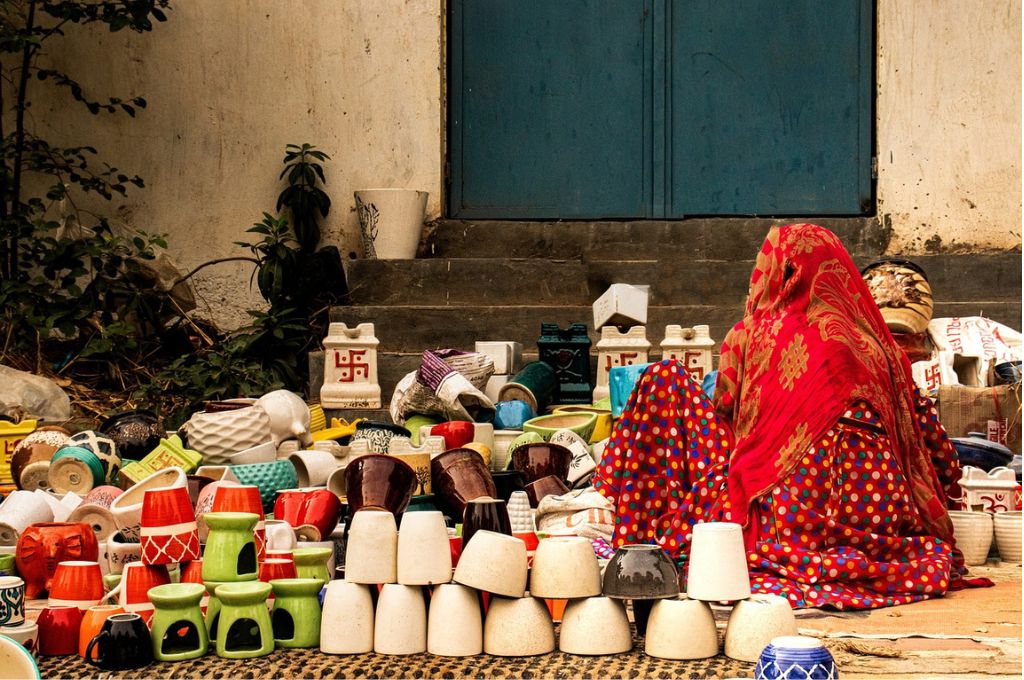The extremely low participation of women in India’s labour force is not a new phenomenon. At 19 percent, India was among the 11 countries with the lowest female labour force participation rates in 2021. Only 20.4 percent of enterprises in India are owned and operated by women. The country doesn’t do well in terms of the gender gap either—it ranks 142nd out of 149 countries in women’s economic participation and opportunity.
Women’s entrepreneurship—with its potential to contribute to job creation, GDP growth, and poverty alleviation—can help improve some of these abysmal numbers, provided we create an enabling environment for women-led businesses.
To help address this gap, Asian Venture Philanthropy Network (AVPN) commissioned a study that maps the landscape of women’s entrepreneurship in urban and peri-urban India and identifies different archetypes of entrepreneurs and opportunities for collaboration.

The study was commissioned with support from JP Morgan and led by the research team at LEAD at Krea University. The research involved a review of relevant literature, including data from the National Sample Survey Organisation, analysis of secondary data sources, and in-depth interviews with various key stakeholders. Here’s what the study found:
Archetypes of women entrepreneurs
The report identifies four archetypes of women entrepreneurs in urban and peri-urban India. These are primarily categorised based on their monthly revenue:
1. Striving/subsistence entrepreneurs
With a monthly income of less than INR 10,000, striving/subsistence entrepreneurs are women who primarily seek to contribute to household income. Their need for flexibility in order to balance care responsibilities and other constraints results in them predominantly operating their enterprises from home.
2. Solopreneurs/homepreneurs
These entrepreneurs have a median monthly income of INR 10,000–25,000. In addition to contributing to household income, this segment seeks to attain economic independence. Given their lack of access to collateral and mobility constraints, they mostly carry out their work from home as well.
The above two archetypes account for close to two-thirds of the women entrepreneurs in urban areas. It is therefore critical that we understand them better and support their growth.

3. Conventional/steadfast entrepreneurs
Conventional/steadfast entrepreneurs have a relatively stable business income, with a monthly revenue of INR 25,000–75,000. Among these enterprises, 22 percent operate out of a fixed store and 15.3 percent possess formal registration. Helping them graduate to the next stage by enabling their access to appropriate interventions and opportunities is the big challenge.
4. Opportunity entrepreneurs
With a median monthly revenue that exceeds INR 75,000, more than half of the entrepreneurs in this segment operate their enterprises out of a fixed store. In addition, 42.24 percent of them—as compared to the 15.27 percent in the conventional entrepreneur segment—lead registered enterprises. Lastly, approximately 28 percent of them have at least one employee that works for their enterprise.
The gender divide is stark and debilitating for women
The report’s comparison of male and female entrepreneurs in urban and peri-urban areas reveals key differences between them. Firstly, a staggering 80.64 percent of entrepreneurs in these areas are men, which means that women entrepreneurs constitute less than a fifth of the market.
The most significant difference however is the distribution of entrepreneurs across segments. The largest proportion (60.87 percent) of male entrepreneurs qualify as opportunity entrepreneurs—the most advanced archetype—whereas only a paltry 4 percent are subsistence/striving entrepreneurs.
This is in sharp contrast to women entrepreneurs, where a significant proportion—38.1 percent—fall within the subsistence/striving segment. Only 16.7 percent of them have managed to grow their enterprises enough to qualify them as opportunity entrepreneurs.
Major differences can also be observed in terms of their revenues and profits. However, interestingly, while male entrepreneurs earn a higher revenue across all segments, the profit margins of women entrepreneurs are consistently higher. This is despite a lower number of women entrepreneurs in the bottom three segments receiving loans. Additionally, across all segments, the women who do receive loans are often provided with less than half the amount that their male counterparts are able to borrow.
Obstacles faced by women entrepreneurs
The lower number of women in the opportunity entrepreneur segment is primarily driven by the multifaceted challenges they face.
1. Agency and norms
“There is a systemic exclusion that begins at the cradle. Being told consistently that she doesn’t belong, is not good enough, smart enough, or capable enough.”—Naghma Mulla, EdelGive Foundation1
- Women experience low confidence in their capabilities or the possibility of their skills being translated into a viable business.
- The existing patriarchal system and its stifling norms restricts their participation in entrepreneurship.
- Women lack the agency to take decisions about themselves and their businesses, and even if they do, they often lack support in handling their household and care responsibilities.
- Most of the women-led enterprises operate out of homes and are concentrated in a few traditional segments, and these characteristics often render them invisible.
2. Access to information, skills, assets, and markets
- Lack of information about relevant government schemes and their requirements prevents women from accessing and benefitting from them.
- Most women-led enterprises have limited or no access to funding such as seed, working, and growth capital from formal financial institutions.
- High input costs and a lack of access to raw materials and/or supplier networks are symptomatic of the poor integration of their enterprises with goods and service markets.
- These entrepreneurs are also hindered by their deficient technical, business management, and financial skills, and the effects of this are exacerbated by the digital divide.
3. Fractured ecosystem
- Restrictive and complex regulations and procedures function as barriers to the registration of their businesses.
- Women entrepreneurs are afforded few networking and mentorship opportunities.
- There is an absence of role models in their peer and community networks.
- Many incubators that serve as a starting point for entrepreneurs in the country have a limited geographic outreach and are unable to reach these women where they are located.

Opportunities for collaborative action
Collaborative philanthropy entails combining assets, specialised knowledge, skills, and relationships to tackle complex issues. As opposed to institutional philanthropy, such an approach offers funders an opportunity to enable systemic change. According to Sharon Buteau, executive director of LEAD, collaborative philanthropy “can play a catalytic role in finding solutions to building the ecosystem for women entrepreneurs and accelerate progress given the varied and rich expertise that can collectively foster transformation in this space.”
Based on the identified challenges and the potential of collaborative philanthropy, the report offers the following recommendations:
1. Move capital towards underserved entrepreneur segments and geographies
Underserved geographies and segments (women entrepreneurs with a monthly revenue of less than INR 75,000) can benefit from a more collaborative approach—one that can address their most pressing challenges. Research has demonstrated that a well-rounded package of interventions can have a greater influence on women’s entrepreneurial activity and business outcomes in comparison to a singular intervention.
Recognising the intersectional nature of the challenges experienced by women entrepreneurs and enabling cross-sectoral collaboration presents an opportunity to break silos. Collaborative philanthropy, which involves channelling resources from multiple donors to nonprofits, can (a) pool in the expertise of funders with experiences in different geographies and sectors and (b) deploy blended financing models, such as a combination of grants, debt, and equity.
The National Skill Development Corporation’s Skill Impact Bond is an example of this approach. It mobilises a coalition of organisations including the Children’s Investment Fund Foundation, British Asian Trust, Michael & Susan Dell Foundation, and JSW Foundation to impart skilling and access to wage employment in COVID-19 recovery sectors to young people across India. Sixty percent of its target group comprises women and girls.
2. Micro approach, macro impact
According to Deepthi Ravula, CEO of WE Hub, “We need to raise the bar on the kind of interventions and support provided for women entrepreneurs, as the current interventions are mainly centred around empowering women than financially enabling more women to be entrepreneurs.”
Therefore, collaborative philanthropy should aim to invest in programmes that can mobilise women entrepreneurs at the community level while simultaneously advocating for change at the regional and national levels.
Collaborative giving can serve as crucial support for a pan-India network of nonprofits and ecosystem partners. It can mobilise aspiring entrepreneurs and forge entrepreneur communities that can function as a peer network and channel for the delivery of services.
3. Drive innovations in solutions and approaches
While a variety of solutions to address credit gaps, skilling requirements, and other challenges already exist, there remains a need for scalable models that can be adapted to benefit different entrepreneur archetypes.
Collaborative philanthropy can channel investments to early-stage entrepreneurship development programmes that have high potential for impact. In addition to accelerating the learning curve for donors and partners, this offers flexible and responsive capital to nonprofits working on the ground to test new ideas.
4. Invest in measurement tools and approaches
The measurement of women’s entrepreneurial activity and the impact of initiatives that foster entrepreneurship is fraught with complexities. Therefore, collaborative philanthropy must invest in longitudinal studies and robust data collection mechanisms that can help bridge gaps and improve the sector’s understanding of how women-led enterprises are established, operated, and scaled over time.
There is a need to look beyond short-term grants and programmes that tackle specific barriers experienced by women entrepreneurs. The report suggests that there is significant room to further tailor interventions to the identified entrepreneur archetypes and strive to scale them. Through an approach that pools funds and expertise of a diverse set of funders, it is possible to address the gaps in present interventions and facilitate real growth.
—
Footnotes
- All quotes in this article are from panels conducted during an event organised by AVPN titled ‘Mobilizing strategic philanthropy to strengthen women entrepreneurs in urban and peri-urban India’.
—
Know more
- Read the full report that this article is based on here.
- Read this article to know more about the factors holding women entrepreneurs back.
- Learn more about a solution to help economically vulnerable entrepreneurs withstand pandemic-induced financial shocks.





